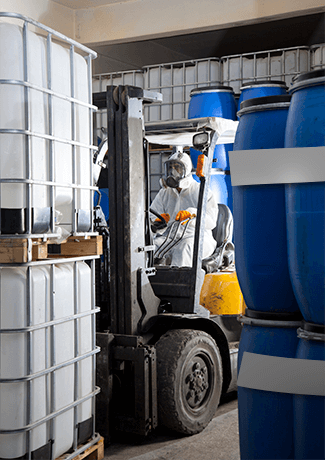3 Ways to Improve Ammonia Handling
03
February,
2023
3 MINUTE READ

For manufacturers, suppliers, and end-users in refrigeration and HVAC, low-charge anhydrous ammonia is all the rage. Using the tiniest quantities of this economical gas, newer compact systems improve efficiency and provide cost savings. Another benefit of using low-charge ammonia refrigeration systems is that it is much safer for workers. However, continuous risk assessments, emergency plans, and communication are still key to compliant, efficient, and safe ammonia management.
Understanding Ammonia
According to the Center for Disease Control and Prevention, anhydrous ammonia is among the top five chemicals causing injuries in acute incidents. The top two causes of the ammonia release accidents were equipment failure and human error. Before any work, employees should understand basic ammonia fundamentals. Recently, a worker was severely burned in an anhydrous ammonia incident at a beef processing plant in Nebraska. The company incurred 16 OSHA violations, including failure to comply with lockout/tagout rules and not following process safety management.
"When employers fail to properly document procedures and control highly hazardous chemicals, there is the potential for unintentional releases that can result in serious and fatal injuries," said Omaha Area Director Jeff Funke. "By implementing and sustaining workplace safety and health programs, employers can monitor their processes to ensure safeguards are in place to protect workers."
While newer, compact systems are easier to maintain, ammonia handling still causes a huge problem for workers when there is a lack of organization and communication. Here are three points to consider to help improve ammonia safety in the workplace:
1. Communicate Clearly
Increasing safety awareness is all about influencing behavior. Safety managers can reinforce conversations on work on or around low-charge ammonia stations by using reminders that catch the eye of an employee or even a visiting contractor. For example:
- Identify ammonia stations and their hazards using chemical notification signs.
- List the contents, hazards, and other instructions on ammonia containers through HazCom labels.
- Workers will know where ammonia pipes are, content pressure, and the direction of its flow through pipe labels.
- Create boundaries to guide workers and traffic around ammonia systems using floor marking.
2. Follow Through on Risk Management
Safety risk management starts with a job hazard analysis. This step is necessary when anhydrous ammonia is in use, according to OSHA. A hazard analysis not only identifies potential danger, but it also helps assess compliance. For example:
- As part of preemptive maintenance, routinely schedule and inspect low-charge ammonia stations for safety and efficiency.
- Place hazard warnings, operating information, and safety reminders directly where a worker will need them when working in or around low-charge ammonia systems.
- Compile a written checklist of safety issues, identify hazards, and evaluate the risk. Include details about chemicals that are part of various tasks.
- Monitor and test ammonia release and pressure relief alarm systems periodically.
3. Continuous Training
 When companies don't keep up on their ammonia equipment and training, they learn the hard way. Breaking down the CDC's most recent ammonia exposure information, there was an average of 46 ammonia release incidents and 115 people injured per year over 10 years. While newer anhydrous ammonia systems improve safety, employers should still:
When companies don't keep up on their ammonia equipment and training, they learn the hard way. Breaking down the CDC's most recent ammonia exposure information, there was an average of 46 ammonia release incidents and 115 people injured per year over 10 years. While newer anhydrous ammonia systems improve safety, employers should still:
- Train and retrain workers for new or changing processes as the system or facilities change.
- Have an ammonia exposure control plan in place as well as emergency response and evacuation plans.
- Clean and organize PPE stations. Use labels to identify gloves, eyewear, and more for ammonia protection.
- Review lockout/tagout procedures for maintenance.
Safety Boosts Efficiency
Having lax procedures when working with ammonia can injure workers and put surrounding communities in danger. Using communication, a solid risk management plan, and continuous training, facility safety managers will enhance productivity and reduce operational costs. When planning risk assessment inspections in 2019, focus on contractors conducting installations, maintenance, and other activities on ammonia systems. By posting instructions and other messages, refrigeration maintenance workers are more likely to pay attention.
Whether you need safety signs, pipe markers, or equipment labels—Toro Max and Kodiak Max are ready to transport anywhere you are. Get help crafting a system that will provide the safety communication you need. Call 1-888-326-9244 and one of our experts will guide you through the process.
Learn more about safety signs, establish and reinforce industry best practices. Download our free OSHA Safety Signs Guide.
| Get the HazCom Instant Action Guide Learn more about HazCom labeling, establish and reinforce industry best practices. |
Read Next:
HazCom Plans Crucial in Preventing Employee Exposure
RELATED RESOURCES

3 Tips to Safely Manage Ammonia
In refrigeration and HVAC, it's out with old, complex systems and in with new, efficient and sleek ammonia ...
Read
Crucial Steps to Reduce Lockout Tagout Violations
Though simple and effective, lockout/tagout is a frequently violated workplace safety standard. Safety ...
Read
GHS-Compliant Safe Storage of Hazardous Chemicals
The Importance of the GHS When working with and storing hazardous chemicals, steps must be taken to ensure ...
Read.png)



